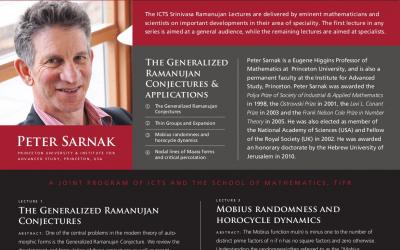Lecture 1: The Generalized Ramanujan Conjectures
Abstract: One of the central problems in the modern theory of automorphic forms is the Generalized Ramanujan Conjecture.We review the development and formulation of these conjectures as well as recent progress. While the general Conjecture is not known, even for GL(2), strong approximations towards it have been establsihed and we will illustrate how these suffice for various striking applications.
Date: 21 May 2012
Time: 11:30 to 12:30
Venue: AG 66
Lecture 2: Thin Groups and Expansion
Abstract: Infinite index subgroups of matrix groups like SL(n,Z) which are Zariski dense in SL(n), arise in many geometric and diophantine problems (eg as reflection groups,groups connected with elementary geometry such as integral apollonian packings, monodromy groups of families of algebraic varieties..). One of the key features needed for number theoretic applications is that these groups obey some form of the Ramanujan Conjectures. In this context this asserts that certain congruence graphs associated with these groups are expanders .We will introduce these ideas and review some of the many recent developments.
Date: 22 May 2012
Time: 11:30 to 12:30
Venue: AG 66
Lecture 3: Mobius Randomness and Horocycle Dynamics
Abstract : The Mobius function mu(n) is minus one to the number of distinct prime factors of n if n has no square factors and zero otherwise. Understanding the randomness (often referred to as the "Mobius randomness principle") in this function is a fundamental and very difficult problem. We will explain a precise dynamical formulation of the randomness and report on recent advances establishing it. In particular the disjointness of the resulting Mobius Flow from horocycle flows and related horocycle dynamics at "prime times".
Date: 23 May 2012
Time: 11:30 to 12:30
Venue: AG 66
Lecture 4 : "Nodal lines of Maass Forms and Critical Percolation"
Abstract : We describe some results concerning the number of connected components of nodal lines of high frequency Maass forms on the modular surface. Based on heuristics connecting these to an exactly solvable critical percolation model, Bogomolny and Schmit have conjectured, and numerics confirm, that this number follows an asymptotic law. While proving this appears to be very difficult, some approximations to it can be proved by developing number theoretic and analytic methods (Joint with A. Ghosh and A. Reznikov).
Date: 24 May 2012
Time: 11:30 to 12:30
Venue: AG 66


